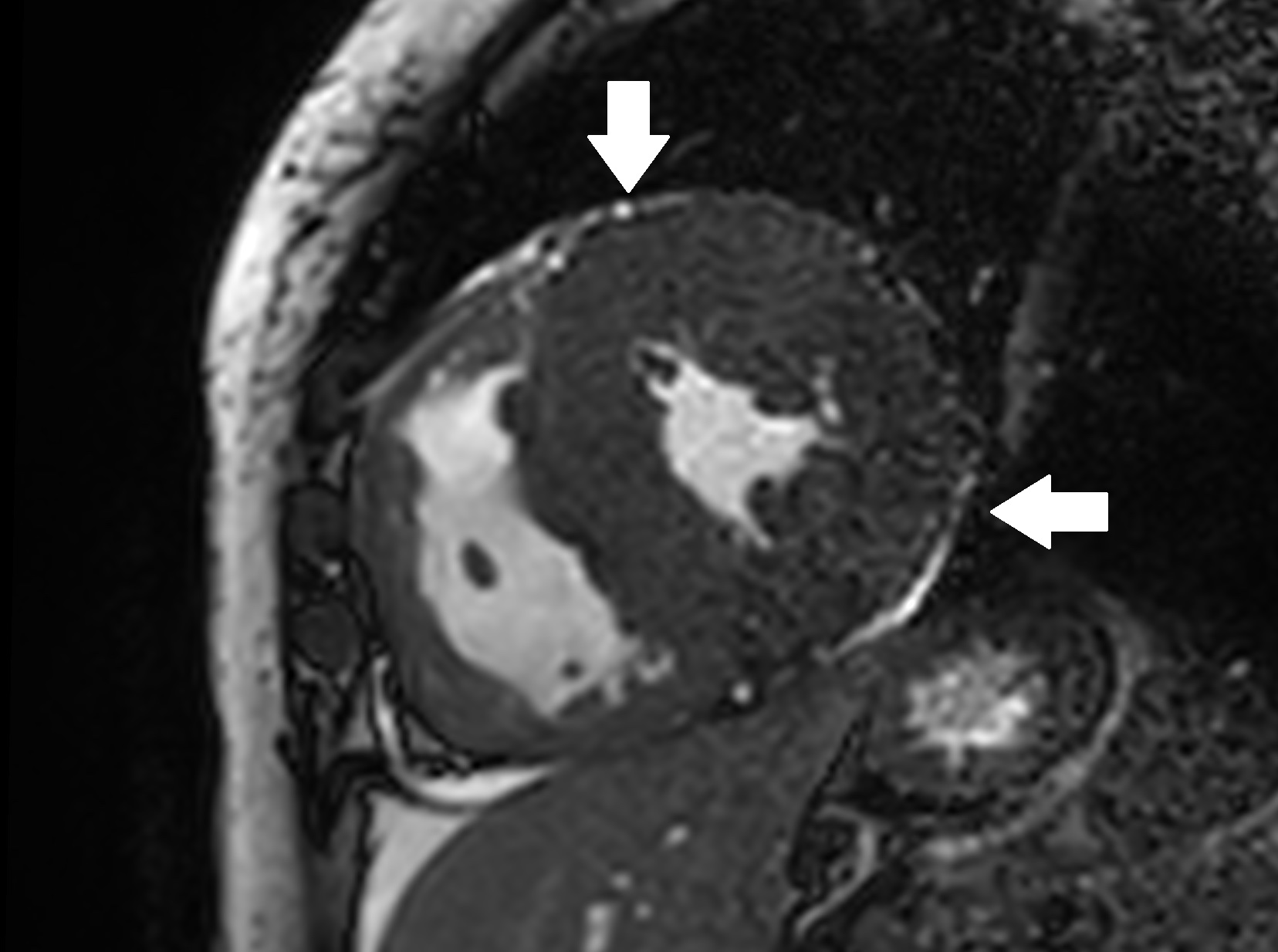Cardiac amyloidosis MRI
|
Cardiac amyloidosis Microchapters |
|
Diagnosis |
|---|
|
Treatment |
|
Case Studies |
|
Cardiac amyloidosis MRI On the Web |
|
American Roentgen Ray Society Images of Cardiac amyloidosis MRI |
|
Risk calculators and risk factors for Cardiac amyloidosis MRI |
Editor-In-Chief: C. Michael Gibson, M.S., M.D. [1]; Associate Editor(s)-in-Chief: Raviteja Guddeti, M.B.B.S. [2]; Aarti Narayan, M.B.B.S [3]
Overview
Amyloidosis is an infiltrative disease resulting in deposition of amyloid in the extracellular spaces of the tissues. Amyloid infiltration of the heart leads to expansion of these extracellular spaces resulting in retainment of gadolinium dye during cardiac magnetic resonance imaging. This retainment of gadolinium leads to signal enhancement in the late washout phase during delayed enhanced cardiac imaging.
Cardiac MRI
CMR findings in cardiac amyloidosis include:[1][2][3][4][5][6]
- Global subendocardial signal enhancement in the late washout phase (late gadolinium enhancement [LGE]) during delayed enhanced imaging. This finding is strongly suggestive of cardiac amyloid as it is rarely seen in other cardiomyopathies.[7][8]
- Increased gadolinium wash-out time
- Abnormal myocardial and blood-pool gadolinium kinetics
- Brighter appearance of the myocardium compared to normal myocardium
CMR has a sensitivity of 88% and a specificity of 95% in the diagnosis and is considered the most accurate predictor of biopsy positive cardiac amyloidosis.
Advantages
- More sensitive than echo as LGE can be present in patients with amyloidosis with normal ventricular wall thickness also.
Dis-advantages
- Caution should be maintained in patients with renal failure.
ACC/AHA Guidelines- ACCF/ACR/AHA/NASCI/SCMR 2010 Expert Consensus Document on Cardiovascular Magnetic Resonance[9] (DO NOT EDIT)
| “ |
CMR may be used for assessment of patients with LV dysfunction or hypertrophy or suspected forms of cardiac injury not related to ischemic heart disease. When the diagnosis is unclear, CMR may be considered to identify the etiology of cardiac dysfunction in patients presenting with heart failure, including
|
” |
Images


References
- ↑ Austin BA, Tang WH, Rodriguez ER; et al. (2009). "Delayed hyper-enhancement magnetic resonance imaging provides incremental diagnostic and prognostic utility in suspected cardiac amyloidosis". JACC. Cardiovascular Imaging. 2 (12): 1369–77. doi:10.1016/j.jcmg.2009.08.008. PMID 20083070. Unknown parameter
|month=ignored (help) - ↑ Maceira AM, Joshi J, Prasad SK; et al. (2005). "Cardiovascular magnetic resonance in cardiac amyloidosis". Circulation. 111 (2): 186–93. doi:10.1161/01.CIR.0000152819.97857.9D. PMID 15630027. Unknown parameter
|month=ignored (help) - ↑ Ruberg FL, Appelbaum E, Davidoff R; et al. (2009). "Diagnostic and prognostic utility of cardiovascular magnetic resonance imaging in light-chain cardiac amyloidosis". The American Journal of Cardiology. 103 (4): 544–9. doi:10.1016/j.amjcard.2008.09.105. PMC 2680134. PMID 19195518. Unknown parameter
|month=ignored (help) - ↑ Maceira AM, Prasad SK, Hawkins PN, Roughton M, Pennell DJ (2008). "Cardiovascular magnetic resonance and prognosis in cardiac amyloidosis". Journal of Cardiovascular Magnetic Resonance : Official Journal of the Society for Cardiovascular Magnetic Resonance. 10: 54. doi:10.1186/1532-429X-10-54. PMC 2605441. PMID 19032744.
- ↑ Hosch W, Bock M, Libicher M; et al. (2007). "MR-relaxometry of myocardial tissue: significant elevation of T1 and T2 relaxation times in cardiac amyloidosis". Investigative Radiology. 42 (9): 636–42. doi:10.1097/RLI.0b013e318059e021. PMID 17700279. Unknown parameter
|month=ignored (help) - ↑ Sparrow P, Amirabadi A, Sussman MS, Paul N, Merchant N (2009). "Quantitative assessment of myocardial T2 relaxation times in cardiac amyloidosis". Journal of Magnetic Resonance Imaging : JMRI. 30 (5): 942–6. doi:10.1002/jmri.21918. PMID 19780184. Unknown parameter
|month=ignored (help) - ↑ Vogelsberg H, Mahrholdt H, Deluigi CC; et al. (2008). "Cardiovascular magnetic resonance in clinically suspected cardiac amyloidosis: noninvasive imaging compared to endomyocardial biopsy". Journal of the American College of Cardiology. 51 (10): 1022–30. doi:10.1016/j.jacc.2007.10.049. PMID 18325442. Unknown parameter
|month=ignored (help) - ↑ Syed IS, Glockner JF, Feng D; et al. (2010). "Role of cardiac magnetic resonance imaging in the detection of cardiac amyloidosis". JACC. Cardiovascular Imaging. 3 (2): 155–64. doi:10.1016/j.jcmg.2009.09.023. PMID 20159642. Unknown parameter
|month=ignored (help) - ↑ American College of Cardiology Foundation Task Force on Expert Consensus Documents. Hundley WG, Bluemke DA, Finn JP, Flamm SD, Fogel MA; et al. (2010). "ACCF/ACR/AHA/NASCI/SCMR 2010 expert consensus document on cardiovascular magnetic resonance: a report of the American College of Cardiology Foundation Task Force on Expert Consensus Documents". Circulation. 121 (22): 2462–508. doi:10.1161/CIR.0b013e3181d44a8f. PMC 3034132. PMID 20479157.
- ↑ Case courtesy of Dr David Cuevas, <a href="https://radiopaedia.org/">Radiopaedia.org</a>. From the case <a href="https://radiopaedia.org/cases/61600">rID: 61600</a>
- ↑ Case courtesy of Dr David Cuevas, <a href="https://radiopaedia.org/">Radiopaedia.org</a>. From the case <a href="https://radiopaedia.org/cases/61600">rID: 61600</a>